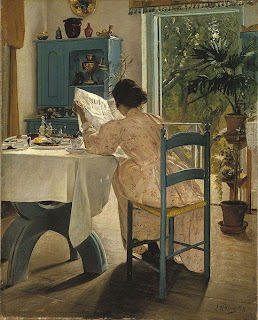No matter what the temperature may be outside, our Breakfast Links are hot, hot, hot! Our weekly roundup of favorite links to other site, blogs, articles, and images, collected for you from around the Twitterverse.
• They weren't always white: slide show of unexpectedly untraditional 19th-20th c. wedding gowns.
• Real life zombies: a history of Cotard's Delusion.
• The resilient little buildings that survived the Great Fire of London in 1666 and can still be seen today.
• Stunning embroidered gentleman's 1785 waistcoat, inspired by an opera.
• Can drinking stinky water improve your health? The spa waters at Bath.
• An embroidery school in Bologna Italy, founded c. 1902 by a N.J. woman to teach poor girls a needlework trade.
• Keeping time in the Victorian kitchen.
• To make a nice Indian pudding: 18th c recipe plus modern adaptation, video.
• Merchant princesses.
• Medieval eyeglasses, dropped in the toilet long ago.
• A handwritten newspaper, produced by Confederate POWs.
• Particularly tasteless Victoriana: murder ornaments.
• Definitely NSFW (but still worth a peek): is this a 17th c. sex manual, or erotic fiction?
• Where did OK come from?
• Two-piece bathing suit just perfect for a 1940s beach beauty.
• A formidable woman in turbulent times: Margaret of Austria, Duchess of Savoy and Regent of the Netherlands, 1480-1530.
• A philosopher's head in a box and a story of execution and utilitarians.
• Collecting images long before Pinterest: an 18th c. print room at Uppark.
• Bitten by a demon? What savage and invisible creature did the "harmless" table-tipping conjure up in 1857 France?
• Fourth of July history myth: Thomas Jefferson wrote the Declaration of Independence.
• Making lemon sponge cake: a Georgian workout with a whisk.
• The Maryland Historical Society is recreating the Star-Spangled Banner, and you can help stitch it, too.
• Romantic fantasy: Caerhays Castle, by 19th c. architect John Nash.
• Famous historical death masks.
• Shower time: early 20th c. drive-thru horse washes in Herald Square, NYC.
• Short history of active wear: bicycle chic & athletic aesthetics.
• Captain John Smith's 1616 letter about Pocahontas from Virginia to Queen Anne of Great Britain.
• "Every night I had lain down expecting death": a rebel woman's diary during the siege of Vicksburg, 1863.
Hungry for more? Follow us on Twitter @2nerdyhistgirls for daily updates!
Laws Concerning Women in 1th-Century Georgia
1 year ago




























 One of us --
One of us -- 


